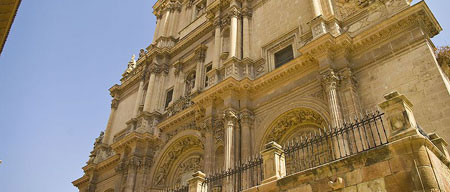Home > Study in Spain > City Guide > Murcia
Murcia City Guide
- Places of Interest
- Maps
- Getting to
- Getting around the city
Located in the south east of the Iberian Peninsula, it is the capital of the autonomous region of the same name and is the seventh largest city in Spain including its encompassing nearby towns. Geographically, Murcia contains a beautiful Huerta and a breathtakingly authentic countryside. The city is also dynamic and exciting with a plethora of cultural hot spots and places to encounter. Not only this, but the city boasts an attractive Mediterranean climate mainly due to its proximity to the sea and average annual temperature remain at about 18°C. In fact, Spain's largest ever temperature was recorded in the city of Murcia which receives more than 2800 hours of sunshine every year and rarely sees a wet or cloudy day. The city has a number of museums, parks, and historical buildings that attract people from afar and what makes this city so popular. It is a representation of true Spanish culture with its famous regional gastronomy yet presents all the modern elements of a booming city to cater for everyone's needs.
Places of Interest
The Casino
Designed and built during the middle of the 19th century, this is one of the most important parts of Murcia's identity and gives the people of the city great pride. The Casino is presented in a number of styles for example the façade is eclectic with both classical and modernist elements and the Moorish patio is sealed with a glass dome and is inspired by both La Alhambra and El Alcázar in Seville. There are a number of other luxurious halls and rooms to visit and each holds a vast history so definitely make a trip here as it would be well worth your visit!
Cathedral of the Diocese of Cartagena
Huellas or "footprints" was the name of the important exhibition taking place in 2002 and this describes the Murcian's cathedral perfectly. It leaves an unforgettable impression on visitor's minds and the citizens of the city are undoubtedly proud of it that they guard it safely. Construction of this Murcian gem began towards the end of the 14th century and the transition through the past few centuries has resulted in a number of different styles such as Gothic, Renaissance and Baroque. The Cathedral has a highly ornate interior and a very impressive exterior also with a large and striking bell tower.
Episcopal Palace
Proudly located next to the majestic cathedral lies the 18th century Bishop's Palace resulting from bishop Mateo's requests for his own residence adjacent to the cathedral. The palace is made up of 2 joined buildings: the martillo (hammer) which is the viewpoint and the main body which has clear Italian influences and it decorated with ornamental frescos. This truly unique and characteristic palace is yet another important site for the Murcians and as it is located next door to the cathedral can be visited at the same time.
Malecón Boulevard
This is the best known Murcian esplanade and stretches more than 15,000 metres into the huerta or agricultural countryside. From it can be enjoyed breathtaking views and places to rest and admire the surroundings. Attached to it can be found the Botanical Garden which is now the largest park in Murcia and there are many benches where you can sit and relax and breathe in the perfect ambiance around you. This is a stunning part of the city that is popular with everyone.
La Fuensanta sanctuary and El Valle regional park
This is the usual residence of the patron virgin of the city and, twice a year, people come to visit her on pilgrimages. It is made up of a traditional temple with beautiful decorations and inside are a number of works of art such as paintings and sculptures of various different artists.
El Valle is a large nature reserve covered in pine trees, craggy rocks and areas of splendid natural beauty. There are even some authentic woodland areas and miraculous views of the surrounding countryside. This is one of the most loved placed to the people of Murcia.
Los Jerónimos
Only a few kilometres from the city centre, lies this well known 18th century monastery in the middle of the Huerta. Declared a National Historical Monument, this monastery has been restored several times and has become the headquarters of the Catholic University of San Antonio, making it one of the cultural focal points of the area. It is highly decorated with a clear Baroque influence and its interior is made of awe striking marble, alabaster and golden wood.
Romea Theatre
Carrying the name of the famous 19th century Murcian actor, Julián Romea, this theatre has suffered two incredulous fires and thorough reconstruction. With evident Neo-classical and modernist inspiration, the building is uniquely pink and grey and the interior painted ceiling represents the coronation of Julián Romea. The Romea Theatre is of great significance in the Spanish theatrical world as it is praised by many for its fantastic artists, beauty, comfort and marvellous acoustics.
Monteagudo Castle
On the top of a hillside lies this beautiful castle where the entire northern valley of the Huerta can be viewed. The town of Monteagudo lies on its hillsides a few kilometres from the city of Murcia. Strategically situated, this was once a military building and recent archaeological finds have discovered pieces of pottery from the Iberian and Roman civilisations. At the summit lies the 14 metre high sculpture of Reparation to the Heart of Jesus which is a replica of the one destroyed in 1926.
Museums
Salzillo Museum
Dedicated to the Murcian Baroque sculpture, Francisco Salzillo, living through the 18th century, this museum is filled with a host of exceptional works and sculptures all based around religious interpretation. Salzillo uniquely always made his sculptures out of wood and is well known for his ability to create intricately detailed masterpieces. Examples of works on show are La Dolorosa which shows an incredible representation of the loss of a son and The Nativity Scene which is a 556 mud figure piece each of 30 centimetres in height and is famous throughout the world.
San Juan de Dios Church-Museum
This Baroque beauty is enveloped in warmth, incense, wax and aromatic plants and contains a majestic display of architecture, sculptures, paintings and music. The church contains pieces dating all the way from the 15th century right up to the 20th and all artworks are accompanied by a Baroque musical background. From time to time, there are live concerts and worship is regularly held in order for the church to retain its original purpose.
Maps
Getting to Murcia
By Air
Reaching the city is easy as the town has its very own Murcia-San Javier Airport (MJV) located on the edge of the Mar Menor close to the towns of San Javier and Santiago de la Ribera lying 45 kilometres southeast of Murcia. The airport hosts a number of international destinations and the city can also even be reached by flying into the airport of neighbouring Alicante.
By Train
The Murcia El Carmen train station has regular services run by the national rail company RENFE. This enables it to be connected to all major cities across Spain therefore the city can easily be reached by this speedy and comfortable mode of transport.
By Bus
Located a few minutes from the city centre, Murcia's bus station makes transport into the city possible from regional, national and even international destinations. Tickets are relatively good value and there are a number of bus companies that run services in and out of the city.
Getting around the city
Of course, it is a delight to walk through Murcia exploring and discovering the sights as you pass them but if you feel like you need a rest or want to take it a bit easier; the option of public transport is readily available in Murcia. Public transport in Murcia is provided by the company LATbus which travels all over the region and service is generally inexpensive and regular. Buses are generally on time and reliable here and there are different types of offers depending on if you want a multitravel ticket or not. Moreover, as of 2007, the city of Murcia has 2 kilometres of tramway running through it provided by the company, Tranvimur. It is scheduled for 4 more tramlines and this will provide a fantastic alternative to the bus to travel around the city.

